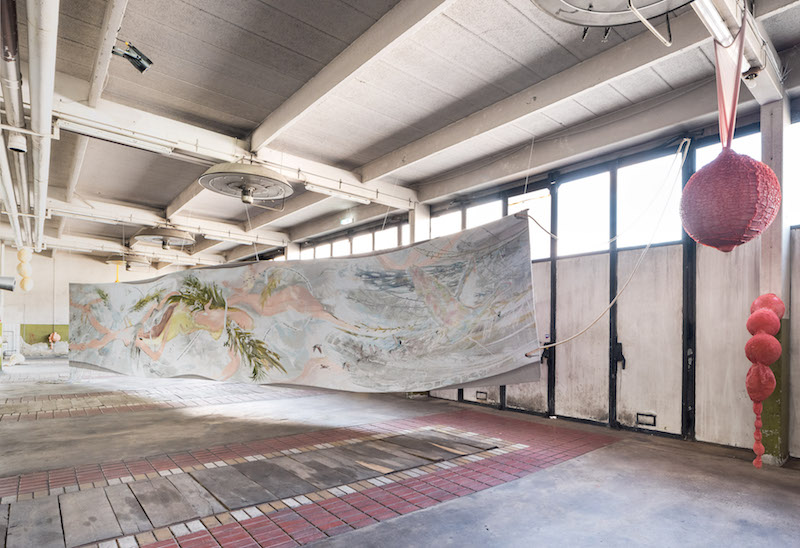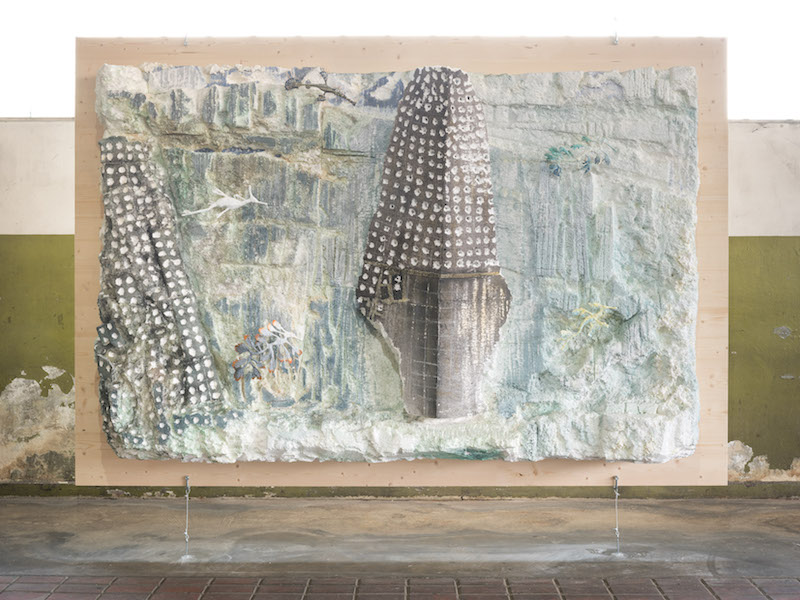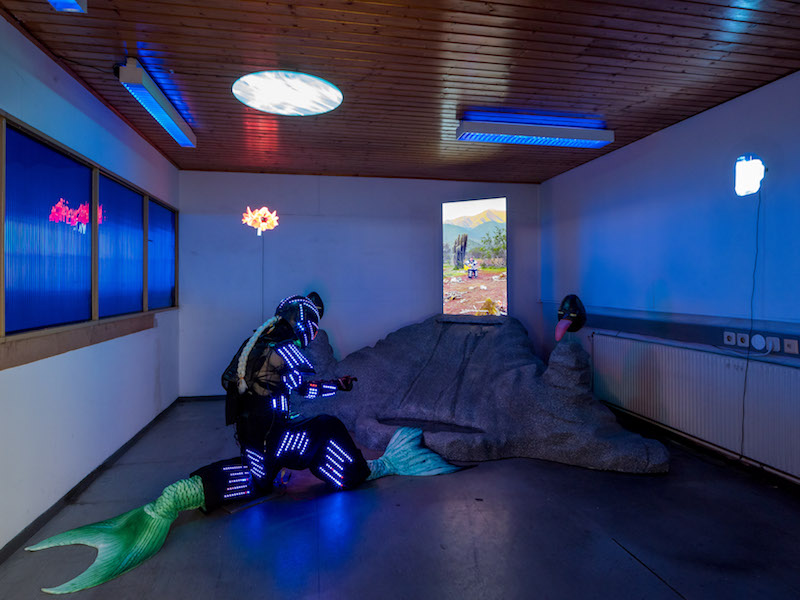by Alison Hugill // July 5, 2024
Within the context of the inaugural Klima Biennale—a 100-day program presented in Vienna this spring, showcasing ecological positions from the fields of contemporary art, design, architecture and science—the group exhibition ‘Songs for the Changing Seasons’ is a touchstone for visitors to connect with the weighty subject matter on a more poetic and emotional level, with artworks that both allude to and manifest aspirations for collective care. The works on view range from playful to grief-stricken, but this spectrum is energetically held throughout the show, contributing to a truthful portrait of our present-day relationship to the natural world.

‘Songs for the Changing Seasons,’ 2024, installation view, Cooking Sections, Eva Fabregas, Natalia Montoya // Photo by Rudolf Strobl, courtesy of Klima Biennale Wien
Curators Filipa Ramos and Lucia Pietroiusti have brought together a group of international artists broadly concerned with the consequences of planetary transformation. Human and non-human songs echo throughout the show, and the artworks feel decidedly personal, despite dealing with problems of a world-historical scale.
The exhibition takes it title from a piece by Ethiopia-born and Stockholm-based experimental singer and composer Sofia Jernberg. The long corridor leading to the so-called Papageienhalle—the main exhibition room in the former train station—reverberates with the sound of Jernberg’s spectral voice, replicating inhuman tones in a dialogue between human and animal sounds. The sound installation prepares us for what’s to come, situating visitors in a headspace that is open to a swarming and teeming chorus of voices.

‘Songs for the Changing Seasons,’ 2024, installation view, Joan Jonas, Eva Fabregas // Photo by Rudolf Strobl, courtesy of Klima Biennale Wien
A series of dozens of delicate blue fish drawings, hung precariously from thin wire using binder clips, form a kind of entry curtain that shields the rest of the exhibition from immediate view. The work, a piece called ‘they came to us without a word’ by Joan Jonas, draws attention to the individuality of each fish as if from a textbook or illustrated guide, but when taken together, the drawings point to something more sinister: the abundance they suggest is also a covert warning, of over-consumption and depletion of the seas. Walking through or around the fragile works-on-paper, we get a sense that throughout the course of the 100-day show they will be easily torn down or ripped by the crowds of visitors, enacting the very vulnerability they seek to address.

‘Songs for the Changing Seasons,’ 2024, installation view, Eva Fabregas // Photo by Rudolf Strobl, courtesy of Klima Biennale Wien
This kind of metaphorical fragility reigns throughout ‘Songs for the Changing Seasons,’ with few works displaying the usual heavy-handed or fear-mongering tactics of climate crisis-themed exhibitions. Here, the point is arrived at through subtler, more poetic means. Eva Fàbregas’ ‘Exudates’—organic looking, soft and rounded sculptures—can be found in almost every corner of the vast hall, like punctuation on the many lines of thought. The artist has literally breathed life into the sculptures, creating wrinkles in the latex as they expand and contract. The surfaces of the works are malleable like human skin, and their shapes resemble internal organs. Sagging, hanging from beams in the industrial hall, they feel like friends, guiding us in their abject and distinct corporeality through the exhibition’s sea of bubbling prophecies.

‘Songs for the Changing Seasons,’ 2024, installation view, Laura Prouvost, Eva Fabregas // Photo by Rudolf Strobl, courtesy of Klima Biennale Wien
Among these is Laure Prouvost’s massive woven tapestry ‘Flying Mother (The Bird Ban Her) Part 2.’ Though the subdued, pastel colours of the threads Prouvost uses give the tapestry an unassuming quality, its mythological stature cannot be overlooked. It depicts a woman in flight, mimicking the patterns of bird migration, with its final ominous words producing a stark reality: “most birds travel alone.” A parallel can be drawn from the role of the mother in contemporary society, fragmented and removed from traditional networks of care and support, and the increasing instances of isolation of individual birds from the flock. The exposed back of the tapestry produces an even more interesting albeit unintentional effect, turning the flying figure into a swimmer in a body of water made of deep blues and greens.
Next to Prouvost’s tapestry, the late German-Iraqi artist Lin May Saeed’s reliefs on styrofoam speak in a strikingly similar visual language. With ‘Sea Dragon Relief,’ Saeed advanced her iconography of solidarity and coexistence between species, merging the delicate creature with a kind of rocky underwater structure that makes it look almost like an architectural model for urban development.

‘Songs for the Changing Seasons,’ 2024, installation view, Lin May Saeed // Photo by Rudolf Strobl, courtesy of Klima Biennale Wien
On the way out of the exhibition hall, a small dark room emits a siren call, luring us in. Patricia Domínguez‘s video installation ‘La Balada de las Sirenas Secas [The Ballad of the Dry Sirens]’ foregrounds the crisis of water privatization in her home country, Chile. The video—which was filmed during the pandemic and documents the water hoarding pools of corporate companies, as well as the violations of avocado and citrus plantations—is set atop a styrofoam mountain cascade. At the bottom of the waterfall but just out of reach, a beached mermaid radiates a technological glow, as though her extreme thirst has made her bionic. As one of the few didactic and unequivocal works in the exhibition, the installation is also one of the few that has its own room, separating it from the rest of the show on an aesthetic level, as well.

‘Songs for the Changing Seasons,’ 2024, installation view, Patricia Dominguez // Photo by Rudolf Strobl, courtesy of Klima Biennale Wien
While voyages to the sea and sky can be found throughout the show, Fàbregas’ bulbous creatures always seem to bring us back to our embodied position. Despite the delicacy and nuance of many of the works that make up ‘Songs for the Changing Seasons,’ a hint of the man-made is never completely out of sight or mind, reminding us of devastations still to come.
Exhibition Info
Klima Biennale Wien
Group Show: ‘Songs for the Changing Seasons’
Exhibition: Apr. 6–July 14, 2024
biennale.wien
Festivalareal Nordwestbahnhof
Nordwestbahnstraße 16, 1200 Vienna, click here for map



















